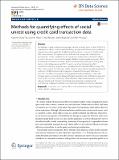Methods for quantifying effects of social unrest using credit card transaction data
Author(s)
Meyer, Joachim; Shmueli, Erez; Bozkaya, Burçin; Dong, Xiaowen; Pentland, Alex Paul
Download13688_2018_Article_136.pdf (4.004Mb)
PUBLISHER_CC
Publisher with Creative Commons License
Creative Commons Attribution
Terms of use
Metadata
Show full item recordAbstract
Societal unrest and similar events are important for societies, but it is often difficult to quantify their effects on individuals, hindering a timely and effective policy-making in emergencies and in particular localized social shocks such as protests. Traditionally, effects are assessed through economic indicators or surveys with relatively low temporal and spatial resolutions. In this work, we compute two behavioral indexes, based on the use of credit card transaction data, for measuring the economic effects of a series of protests on consumer actions and personal consumption. Using data from a metropolitan area in an OECD country, we show that protests affect consumers’ shopping frequency and spending, but in noticeably different ways. The effects show strong temporal and spatial patterns, vary between neighborhoods and customers of different socio-demographical characteristics as well as between merchants of different categories, and suggest interesting subtleties in purchase behavior such as displaced or delayed shopping activities. Our method can generally serve for the real-time monitoring of the effects of major social shocks or events on urban economy and consumer sentiment, providing high-resolution and cost-effective measurement tools to complement traditional economic indicators. Keywords: Social shocks; Economic effect; Consumer behavior; Spatiotemporal pattern; Credit card transaction
Date issued
2018-04Department
Massachusetts Institute of Technology. Media LaboratoryJournal
EPJ Data Science
Publisher
Springer
Citation
Dong, Xiaowen et al. "Methods for quantifying effects of social unrest using credit card transaction data." EPJ Data Science 7 (April 2018): 8 © 2018 The Author(s)
Version: Final published version
ISSN
2193-1127